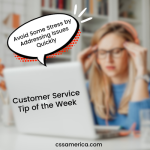
The following is a true story of a customer service runaround…
- Nate’s physician suggested that he have a diagnostic procedure.
- The hospital called Nate to schedule the procedure; they suggested he get the CPT code (procedure number) since Nate wanted to get an estimate of the procedure charges.
- He called his physician office and got the CPT code.
- At the direction of the physician office, he called another office (in another town) for an estimate. He okayed the procedure based on the estimate being somewhat reasonable.
- Nate had the procedure and received results – all were good!
- He received the bill – 60% above the estimate.
- He called Billing and talked with Kristin. She said that they billed correctly, but Nate was only given 1 of the 2 CPT codes and was told the wrong estimated price; Kristin told him to talk to the insurance company and have them possibly appeal to the office (which was part of the same company as Billing, which was also the same company as the scheduler, which was also the same company as the estimator).
- Insurance said that they may be able to do something if the physician office said that the procedure wasn’t warranted.
- The insurance company called the physician office for Nate and left a message at the physician office.
- The office called Nate and said the procedure in question was ordered correctly, but they were adamant that they don’t give out CPTs – so they couldn’t help with his issue; they suggested that Nate call Scheduling – maybe they give out CPT codes.
- Nate called Scheduling; they said that they don’t give out CPTs; they suggested he call the Estimate department.
- Nate called the Estimate department; they said they don’t give out CPTs, but the supervisor would call him the next day because she may have access to information that the front line employee couldn’t access.
- Nate called a week later after having received no call back, and he left a message.
- The Estimate department called back and said to call Billing.
- Nate called Billing, and the lady he spoke with sounded familiar – she was Kristin. She said the physician office wasn’t telling the truth when they said they don’t give out CPTs.
One procedure and fifteen communications. There was no resolution, no ownership, and no accountability. Most of the conversations were with one company and four different departments/offices, but they operated as if they were four separate companies.
In most of the conversations, the individual employees were personable and somewhat helpful – they probably received good evaluations for their actions during the call. But from Nate’s perspective, this was a royal mess.
Don’t assume that one pleasant conversation equates to one happy customer. Ensure the company isn’t giving the customer service runaround.
Signup for FREE Tips! Contact Us More Resources for You Visit Our Home Page























